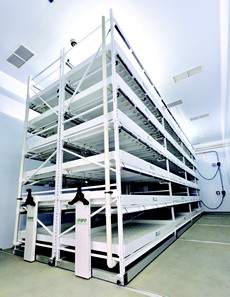Cultivating high quality medical and/or recreational cannabis creates many challenges for experienced and novice growers. Just as any other agricultural or medicinal crop, consistency of trait expression from batch to batch is critical for operators and consumers. However, achieving such consistency comes at a cost in both capital and operational expenditures. Craft cannabis growers and large corporate multi-state operators are seeking new technologies and equipment to help maximize every square foot of their cultivation facility to ensure consistency and profit margins as markets mature and consolidate.

Space optimization
Pipp Horticulture, a division of Pipp Mobile Storage has been helping the largest retailers in the world maximize and manage inventory storage for the past 40 years and now the largest cannabis operators in the world. “When it comes to optimizing spaces, we know what to do,” says John Ritter, Director of Sales with Pipp Horticulture. “When we entered the cannabis sector, we spent a substantial amount of time understanding how to best serve this industry. We had a lot of knowledge regarding vertical racking, and we wanted to use it to empower growers and make them successful. Thus, we have team members that are extremely knowledgeable with regards to everything that factors into growing cannabis in indoor farms. We don’t focus on our equipment solely, but we have studied how to integrate all sorts of different solutions from other suppliers with ours, in order to advise our customers on how to make it work together with all the rest of the equipment within the operation.”
“No two growers are the same”
Pipp Horticulture is dedicated to working directly with operators big and small to meet their specific needs and assist in bringing their vision to life. “Though no two growers nor their cultivation strategies are the same, we are starting to see some consistent approaches in terms of equipment selection and strategy,” says Michael Williamson, Director of Cultivation for Pipp Horticulture. “Though the majority of our clients are electing to use LED lighting, due to allowance for close proximity to canopy and form factor for vertical stacking, we have a significant number of clients going vertical with CMH, LEC and even HPS lighting. We are also seeing clients electing to go single level with our equipment for phase 1 and pre-planning with additional electrical distribution and HVAC for going to multi-level as a phase 2 strategy by simply adding a tier of second trays and lights. This strategy does have an increase in capital costs upfront but allows for quick speed-to-market phasing approach that eliminates additional construction.”

Some states in the US have limited plant counts which encourage growers to cultivate larger plants to maximize yield. However, there are other states, or countries, where growers are limited by canopy and not plant count. Growers that are regulated by canopy are shifting away from large plants to medium sized plants with high density plant spacing. This allows for shorter vegetative times and labor reduction for defoliating and harvesting. “Another trend we have been seeing with the acceptance of multi-level vertical cultivation is growers who elected for two levels in flower for phase one build outs are now electing for three levels in flower for the future phases,” according to Michael.
Benefits of growing vertical
“We are seeing a big shift from single level HPS cultivation to multi-level LED. Operators and investors who are planning to be sustainable and profitable in the future as markets mature and price per pound compresses are simply looking at the yield metrics and cost of goods sold associated with multi-tier vertical farming. When quantifying yield for single level HPS cultivation, most growers are modeling for 1.5-2 pounds per light (16-20 square feet) with some claiming 3+ pounds per light (usually cultivar specific). When you quantify a two-tier multi-level mobile rack approach for the same square footprint and the same yield modeling, growers are achieving 4-6 lbs. Experienced vertical growers who elect for a three-tiers are achieving 6-9 lbs in the same square footprint as the single level HPS grower who is only achieving 2-3 lbs.”
Pipp has been a pioneer in the vertical farming space, supporting growers in better understanding this concept, and providing them with full solutions that address a grower’s facility as a whole. “We have fully embraced this industry, and we want to bring our expertise in space optimization,” says Curtis Dadian, National Sales Manager with Pipp Horticulture. “But not only that, as thanks to experienced cultivators on our team, we can provide our clients with full assistance, and help them in using their facility in the most efficient way. We addressed this aspect, and we have created a functional and workable solution that can integrate all different kinds of brands and facilities.”
For more information:
Pipp Horticulture
2966 Wilson Drive NW
Walker, Michigan 49534
P: 616-988-4044
F: 616-988-4045
info@pipphorticulture.com
pipphorticulture.com
Publication date:
© MMJDaily.com / Contact
Link to original article: https://www.mmjdaily.com/article/9165030/we-are-seeing-a-big-shift-from-single-level-hps-cultivation-to-multi-level-led/

